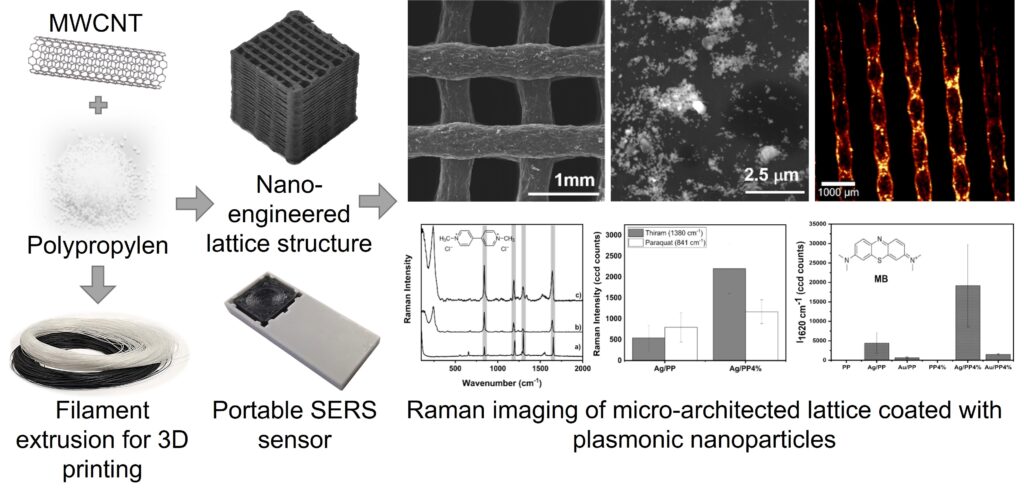New water pollution monitoring system set to make a splash
A team of researchers from universities in Scotland, Portugal and Germany have developed a new water pollution sensor which can be printed on 3-D machines, making it readily available everywhere at a very low cost. According to scientists at the Glasgow University, which leads the team of scientists involved in the sensor’s development, the sensor can help detect the presence of very low concentrations of pesticides in water samples.
Their scientists have published their research in a paper published in the journal Macromolecular Materials and Engineering, and say that the sensor could make water monitoring quicker, easier and more affordable.
In a press statement, Glasgow University team says that pesticides are widely used in agriculture around the world to prevent the loss of crops. However, they must be carefully handled, since even small spills into soil, groundwater or seawater can be harmful to human, animal and environmental health.
In view of rising water pollution around the world, especially in poor and low-income nations where regulations are not properly implemented, regular environmental monitoring is critically important to minimising water pollution, enabling swift action when the presence of pesticides is detected in water samples. Currently, pesticide tests are most often carried out in laboratory environments using techniques including chromatography and mass spectrometry.
While these tests provide reliable and accurate results, they are time-consuming and expensive to perform. One promising alternative is a chemical analysis tool called surface-enhanced Raman scattering, or SERS.
When light hits molecules, it scatters in a way that has distinctly different frequencies depending on the molecular structure of the molecule. SERS allows scientists to detect and identify vestigial amounts of molecules in test samples adsorbed on a metal surface by analysing the unique ‘fingerprint’ of how the molecules scatter light, says the statement by Glasgow University.
The effect can be enhanced by improving the metal surface to enable it to adsorb the molecules, boosting the ability of sensors to detect low concentrations of molecules in samples.
The research team set out to develop a new, more portable method of testing that could use affordable, 3D-printed materials to adsorb molecules from water samples and deliver accurate initial results in the field.
To do so, they explored several different types of cellular architectures made from mixtures of polypropylene and multi-walled carbon nanotubes. The architectures were produced using fused filament fabrication, a common type of 3D printing.
The surface of the cellular architectures was coated with silver and gold nanoparticles using a common wet chemical approach to enable the surface-enhanced Raman scattering process.
They tested the ability of several different architected designs of the 3D-printed cellular materials to uptake and adsorb molecules of an organic dye called methylene blue, before they were analysed by a portable Raman spectrometer.
The best-performing material from those initial tests, a lattice design combined with silver nanoparticles, was then added to test strips. Samples of sea and fresh water spiked with low amounts of real pesticides called thiram and paraquat were dropped onto the test strips for SERS analysis.
The water was drawn from an estuary in Aveiro, Portugal and from taps in the same area, locations which are subject to regular real-life water pollution monitoring tests.
The researchers found that the test strips were capable of detecting molecules of both pesticides at concentrations as low as 1 micromolar, equivalent to one molecule of pesticide to a million molecules of water.
Professor Shanmugam Kumar, of the University of Glasgow’s James Watt School of Engineering, is one of the corresponding authors of the paper. The work builds on his research in using 3D printing techniques to create nanoengineered architected lattices with unique properties.
“SERS is a valuable diagnostic technique with applications in a wide range of different fields. The sensor substrate material we’ve developed benefits from a an optimal combination of the nanocarbon-engineered architected lattice’s large surface area and the remarkable optical properties of the metallic nanoparticles. The interaction of the strong local electromagnetic field in the metallic nanoparticles and the carbonaceous material’s chemical mechanisms creates a highly active surface for SERS analysis,’’ says Kumar.
“The results of this initial study are very encouraging, showing that these low-cost materials can be used to produce sensors for SERS detection of pesticides even at very low concentrations,” he adds.
Dr Sara Fateixa, of the University of Aveiro’s CICECO Aveiro Institute of Materials, co-authored the paper and designed the plasmonic nanoparticles which enable the SERS technique. “While this paper examines the potential of the system to detect specific types of water pollutants, the technique could easily be adapted to monitor the presence of a wide range of chemicals in samples. In farming, for example, the milk from cattle, who are recovering from an illness, which was treated with antibiotics can’t be sold until after the drug has left their systems. Currently, the tests which prove their milk is ready to go back on the market are expensive, but our diagnostic materials could be tuned to provide reliable results much more affordably,’’ she said.
“We are looking forward to continuing to develop this very promising sensor material for use in SERS applications,” she added.
According to the statement, researchers from the University of Glasgow in the UK, the University of Aveiro in Portugal, and HTWK Liepzig in Germany contributed to the paper.











